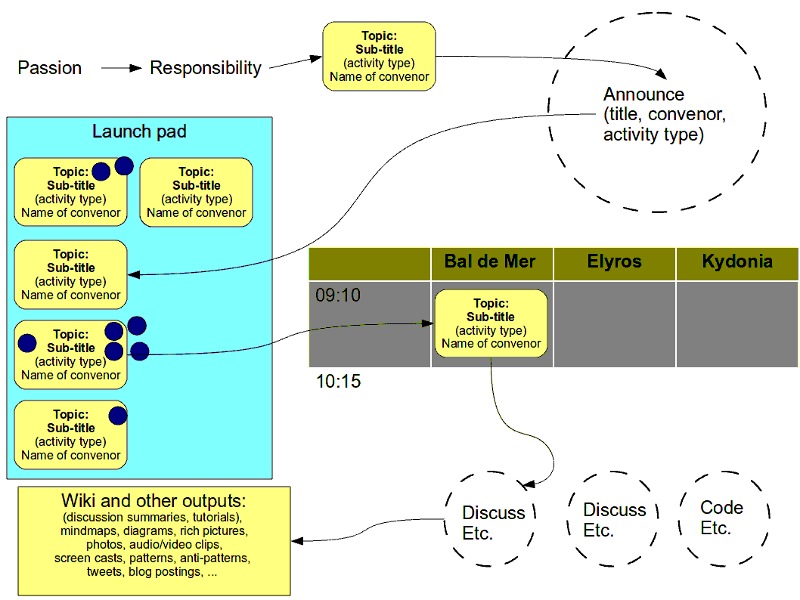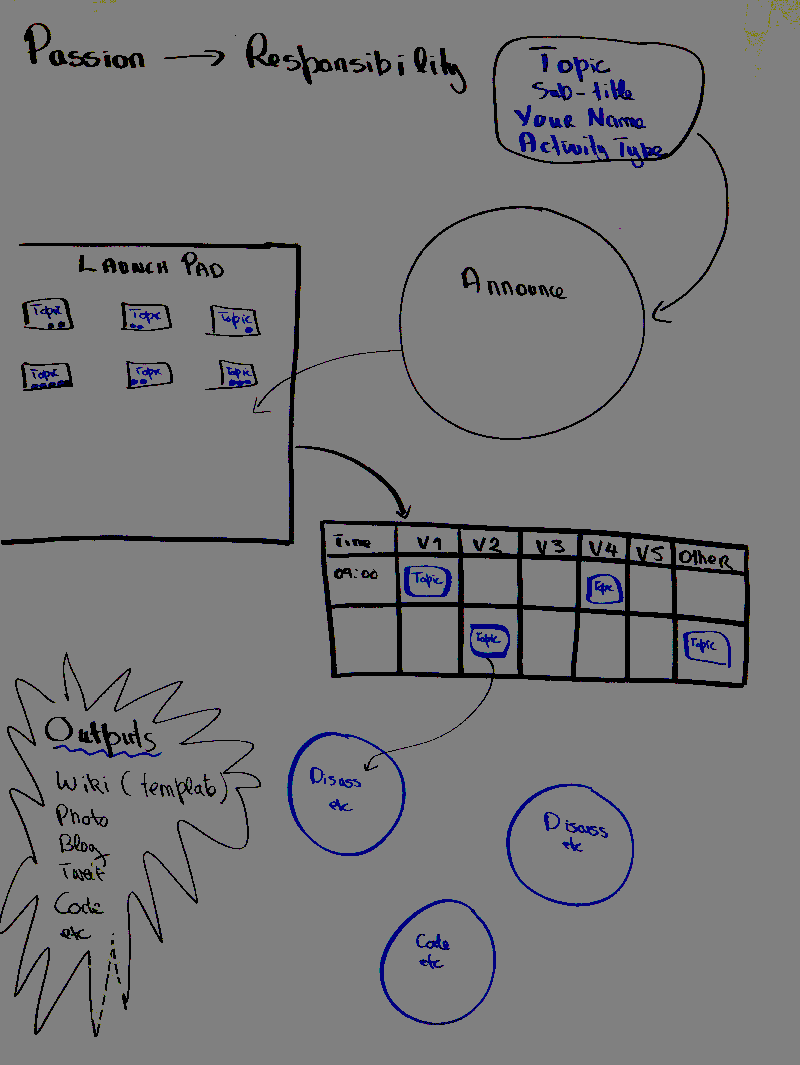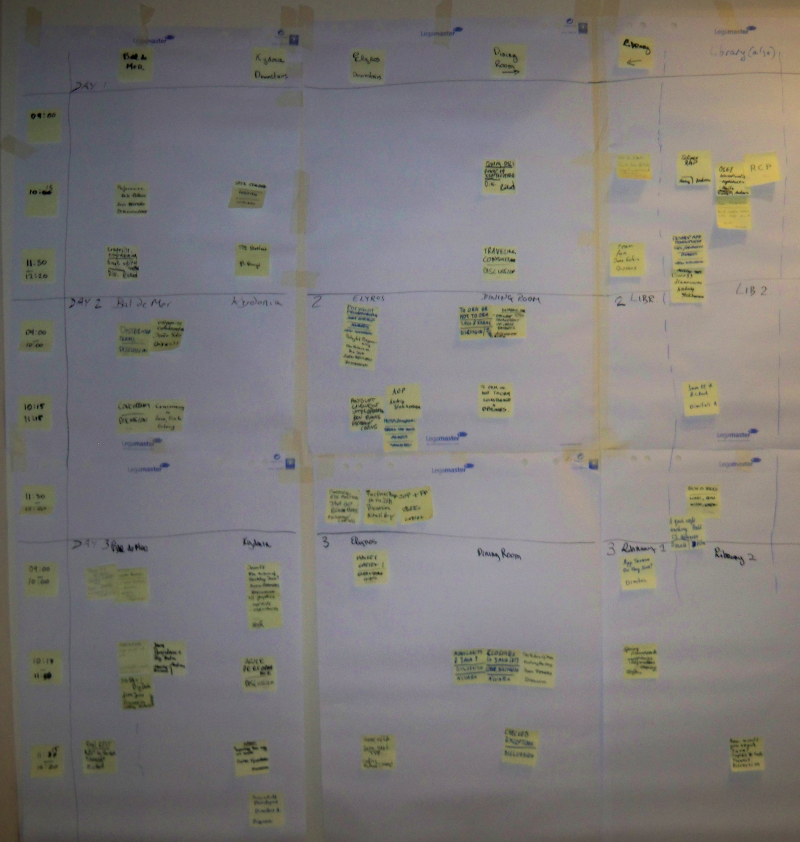The open spaces unconference is the coolest structure for exchanging ideas. The Open Space format has been used more than 60,000 times in at least 124 countries, involving millions of attendees over the past 20 years, so it obviously “just works”. As JCrete® uses it, it is important to understand what type of event an open spaces unconference is.
Simple Rules
To maximize what you can get out of the unconference, simple rules apply. Wikipedia summarizes them nicely:
- Whoever shows up are the right people
…reminds participants that they don’t need the CEO and 100 people to get something done, you need people who care. And, absent the direction or control exerted in a traditional meeting, that’s who shows up in the various breakout sessions of an Open Space meeting. - Whenever it starts is the right time
…reminds participants that spirit and creativity do not run on the clock. - Whatever happens is the only thing that could have
…reminds participants that once something has happened, it’s done—and no amount of fretting, complaining or otherwise rehashing can change that. Move on. - Wherever it happens is the right place
…reminds participants that space is opening everywhere all the time. Please be conscious and aware. - When it’s over, it’s over
…reminds participants that we never know how long it will take to resolve an issue, once raised, but that whenever the issue or work or conversation is finished, move on to the next thing. Don’t keep rehashing just because there’s 30 minutes left in the session. Do the work, not the time.
Be prepared to be surprised! 🙂 Engage with the process.
In short:
- An unconference is a participant-driven meeting. In other words: you decide what topics you want to talk about, and work on, with whom – instead of hoping a “speaker” will address that topic at least briefly.
- Open Space (“Open Space Technology”, OST) is a specific form of an unconference that starts with an empty schedule. No topics are mandated, no separations are made between “speakers” and “audience”. All participants work out a schedule by suggesting, planning, holding and evaluating sessions, collaboratively.
- Since everything is created collaboratively by the participants, obviously it matters which people feel invited, and how to “call” them together. This is one of the reasons that JCrete® is an invitation-only event.
What does a day look like at JCrete®?
- Every morning of the event, we all gather in the big conference room and, after a welcome note, you are given post-its and pens for you to write down topics/ideas (in the format <title, name of proposer>) you would like to discuss/present. Remember, that you are a speaker of this event! By proposing a topic you are also volunteering to convene the session and ensure that any required outputs are produced. So, only propose a topic if you are willing to take responsibility for it (e.g. you are an expert or you passionately want to learn about that topic).
- Then, each proposer does a 20 second pitch for their topic(s) to attract participants (try “speed geeking“).
- The post-it(s) go(es) to the launch pad for initial clustering; then the disorganisers try to group each post-it to similar topics and find an appropriate slot for it in the Space-Time matrix, in coordination with you.
- When everyone has finished, a draft schedule for the first day, at least, has been created. Now it’s time to start the first sessions. Whoever posted the topic is the “convenor” who might like to lead the discussion, though groups may self-organise and optionally assign various roles (e.g. scribe, rapporteur, …) to ensure required/desired outputs are produced and stored in the WikiEducator in a Space-Time matrix. Each convenor goes to different corners of the conference room and does a simple sign-up approach with hands/feet in order to see how many are interested in their talk in order to decide which room to choose. Each group follows the convenor in the appropriate room while the disorganisers adapt the Space-Time matrix accordingly. Typically, small groups of participants have their sessions in breakout rooms (or wherever they want to – the beach for example).
- During the session, each convenor (the one that proposed the talk or an assigned one) is responsible for gathering the content, managing the questions and sorting out issues as they come, and collecting/recording any output/outcome in flip-charts, photos, audio/video recordings etc.
- Periodically or after each session, everybody gathers again in the large, central conference room, to share the “harvest” of their sessions with everybody else, e.g. by creating a gallery of all session results. Imagine that flow of people like an inhale-exhale rhythm, with the central space being the “lungs”.
- All over the day, depending on harvests and ideas, sessions might be merged, created, canceled, … – that’s the magic of unconferences, it works every time, no single mastermind needed! The disorganisers are responsible for re-arranging the Space-Time matrix as well as the schedule in github. Make sure to be constantly updated with this content.
Each other day (except from the last one where a hack day is setup) follows the same steps 1-7.
During the Event
During the event, everything may change as participants collectively decide what will happen via a face-to-face process similar to the above, perhaps using post-its, white boards and flipcharts. Topics suggested in any pre-event exercise might re-emerge but expect new ideas as the collective creative energy flows.
Open Spaces has only one “law”:
The Law of Two Feet:
“If at any time you find yourself in any situation where you are neither learning nor contributing: use your two feet and go someplace else”.
i.e. don’t waste time, move around, cross-pollinate groups, and be open to chance encounters which often bring out the most creative of discussions.
If you want to go to two discussions in the same time slot, try negotiating a change to the schedule (preferably during its composition).
The schedule may include opportunities for people to report back on their discussions.
Concrete Outputs?
Open spaces are open spaces with no pre-set agendas, tracks, outputs or outcomes. The participants self-organise and:
- take responsibility to raise issues of concern
- discuss issues to the full extent desired
- produce reports (on-the-fly) – e.g. on a wiki (like this one 🙂
- feel free to record (photo, audio, video) and post to or link from this wiki, blog, tweet, etc.
- all contributions to this wiki are licensed Attribution-ShareAlike 3.0 (Unported CC BY-SA 3.0) – see WikiEducator’s copyright notice.
- typically the convenors will help facilitate this happening but the responsibility for doing it lies with each group.
- feel free to record (photo, audio, video) and post to or link from this wiki, blog, tweet, etc.
- and, where applicable and desired, create spaces for setting priorities and developing action plans (if applicable).
Further Information
For more background see the following and associated links:
- Owen, Harrison (2008). Open Space Technology: A User’s Guide (3rd ed.). Berrett-Koehler. ISBN 978-1576754764.
- Some great videos and other resources may be found on the web.
https://youtu.be/-fm8ZaoYOsU



